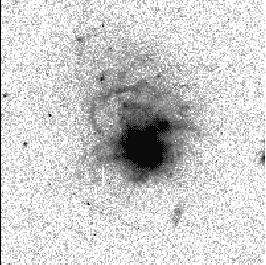


5.2 SBS0335-052
For a long time I Zw18 seemed to play in its own league, with no other BCG
coming really close to its low oxygen abundance in the H II-gas. However
the entrance of SBS0335-052 on the stage changed the situation.
This galaxy was found in the Second Byurakan Survey (SBS,
Markarian and
Stepanian 1983).
A number of papers
from 1990 and onwards have shown it to be a galaxy with an oxygen abundance
comparable to that of IZw18
(Izotov et al. 1990,
1997b;
Melnick et al. 1992).
Melnick et
al. (1992) and
Izotov et al. (1997b)
both find an oxygen abundance of 1/40 of the solar value. The analysis by
Melnick et al. (1992)
suggest that the
O abundance may be a factor of two higher in a north-western H II region.
Thuan et al. (1997)
argues that the oxygen abundance in the neutral gas
may be even smaller by a factor 100. Mid infrared observations with ISO
revals the presence of dust, and a gas to dust ratio typical for more
metal rich BCGs
(Thuan et al. 1999).
VLA observations have
revealed an H I mass of ~ 2 x 109 M and a dynamical mass a factor
of a few larger
(Pustilnik et
al. 1999).
An image of SBS0335-052 from the HST
archive (see also
Thuan et al. 1997)
is shown in Fig. 9 and reveals a complex
morphology. Like IZw18, SBS0335-052 has a faint companion galaxy
(Sect. 5.2.1).
and a dynamical mass a factor
of a few larger
(Pustilnik et
al. 1999).
An image of SBS0335-052 from the HST
archive (see also
Thuan et al. 1997)
is shown in Fig. 9 and reveals a complex
morphology. Like IZw18, SBS0335-052 has a faint companion galaxy
(Sect. 5.2.1).

|
Figure 9. SBS0335-052 imaged with the Hubble Space Telescope in the V-band, cf. Thuan et al. (1997). The size of the image is 20 x 20 arcseconds corresponding to 5.2 x 5.2 kpc. Note the extended complex filaments. (Obtained from the HST archive.) |
There have been several claims that this galaxy is a truly young galaxy,
not containing any underlying old population,
(Thuan et al. 1997,
Izotov et al. 1997b,
Papaderos et al. 1998).
The argument put forward
is the low metallicity and the lack of any underlying population in
surface photometric data. However
Lipovetsky et
al. (1999)
in their study of the companion, present also surface photometry of SBS0335-052. The
R - I colours at a radius of 10 arcseconds is (R - I) = 0.4 which
indicates an
age of several Gyr for a single stellar population model with metallicity 2%
solar and a standard Salpeter IMF (Bruzual and Charlot 2000).
Nebular gas contamination
cannot account for this, since that would make R - I bluer, leading to
an underestimate of the age.
Even allowing for an internal extinction of E (B - V) = 0.2 an
age of 1 Gyr or more is required.
Changing IMF, or metallicity (to 20% solar)
still leads to an age in excess of 1 Gyr. Relaxing the assumption of
instantaneous star formation, and allowing for more realistic SFHs would
increase
the age to around 10 Gyr (for  = 3
Gyr, cf. Sect. 5.1.2). Thus,
in view of the surface photometry presented by
Lipovetsky et
al. (1999),
the age of > 1 Gyr can be regarded as a conservative lower limit.
Moreover the presence of red star clusters
(Östlin 1999b)
suggests an age of several Gyr. These star clusters were discussed by
Papaderos et
al. (1998)
but the models they used to interpret
the ages do not agree with other published models, and are apparently
erroneous leading to an underestimate of the age of the clusters. Thus,
SBS0335-052, like IZw18, is probably not a genuinely young galaxy.
In some sense SBS0335-052 is more extreme than IZw18 in that despite being
almost as metal-poor as IZw18, it is more luminous (MB
= -16.7) and thus
lies further off the metallicity-luminosity relation for dIs, see
Fig. 10.
= 3
Gyr, cf. Sect. 5.1.2). Thus,
in view of the surface photometry presented by
Lipovetsky et
al. (1999),
the age of > 1 Gyr can be regarded as a conservative lower limit.
Moreover the presence of red star clusters
(Östlin 1999b)
suggests an age of several Gyr. These star clusters were discussed by
Papaderos et
al. (1998)
but the models they used to interpret
the ages do not agree with other published models, and are apparently
erroneous leading to an underestimate of the age of the clusters. Thus,
SBS0335-052, like IZw18, is probably not a genuinely young galaxy.
In some sense SBS0335-052 is more extreme than IZw18 in that despite being
almost as metal-poor as IZw18, it is more luminous (MB
= -16.7) and thus
lies further off the metallicity-luminosity relation for dIs, see
Fig. 10.